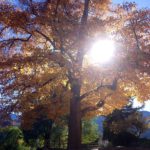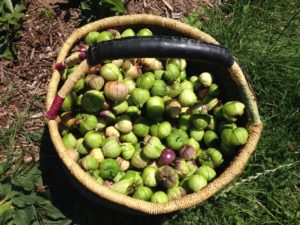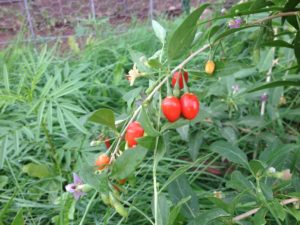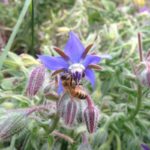We are always growing here at Smokebrush Farm, tending to the Earth in a way that honors its rhythms, harmonies, and cycles. We are transforming some of the oldest and most beautiful lawns in all of Manitou Springs into an educational hi-production farm, where we practice biodynamics to reach a level of Serious Sustainability.  We acknowledge that the Farm is an organism – a whole with interconnected parts – and we work to revere all of the systems and synchronicities in place that allow the Being to function. With these values in heart, we work to increase food security through access to biodynamic products and processes. We grow soil to tend to the needs of plant and fungus life, a miniature potbelly pig, Coturnix quail, Nubian dairy goats, top-bar beehives, and several heritage breeds of livestock such as Silver Fox rabbits, Icelandic chickens, and Cayuga ducks. Our intentional slow compost heaps are sacred to us because we understand that the vitality of each farm is in the soil.
We acknowledge that the Farm is an organism – a whole with interconnected parts – and we work to revere all of the systems and synchronicities in place that allow the Being to function. With these values in heart, we work to increase food security through access to biodynamic products and processes. We grow soil to tend to the needs of plant and fungus life, a miniature potbelly pig, Coturnix quail, Nubian dairy goats, top-bar beehives, and several heritage breeds of livestock such as Silver Fox rabbits, Icelandic chickens, and Cayuga ducks. Our intentional slow compost heaps are sacred to us because we understand that the vitality of each farm is in the soil.


This year, the soil grew countless edible and cut flowers, salad greens, kale, cauliflower, kohlrabi, wild edible greens, corn, potatoes, tomatoes, carrots, goji berries, squash, pumpkins, and a bounty of herbs. To diversify the organism, we are also cultivating oyster mushrooms, elderberries, asparagus, fig trees, peach trees, hazelnut trees, paw-paw trees, raspberries, blackberries,strawberries ,blueberries, grapes, and kiwi. Our holistic approach, which highlights needs over wants, helps us listen to the land and understand that every being has a purpose and can be woven into their proper place on the Farm. Our practices stem from biodynamics, a holistic, ecological, and ethical approach to farming. Initially developed by Dr. Rudolf Steiner (1861-1925) nearly a century ago, biodynamics forever altered the way we understand farming today, though you may not have known it. In the 1940s, an English scholar and practitioner of biodynamics coined the term “organic” to describe the practice, descendent from Steiner’s description of the “farm as organism.” Through the rest of the 20th century, the term “organic” became popularized and began to evolve. Biodynamic farmers in the US launched the first Community Supported Agriculture (CSA) program in the 1980s, allowing consumers to literally buy into the costs of farming at the beginning of a growing season, ultimately rekindling the small farm model. It wasn’t until 2002 that the USDA created the National Organic Program (NOP) to certify products as USDA Organic, which enforced a regulated set of standards. The key difference between biodynamic and USDA Organic are the methods used, with an emphasis on biodiversity and integration in biodynamic practice. We at Smokebrush Farm integrate this complex history into our approach as we work toward becoming a certified biodynamic farm.
Our practices stem from biodynamics, a holistic, ecological, and ethical approach to farming. Initially developed by Dr. Rudolf Steiner (1861-1925) nearly a century ago, biodynamics forever altered the way we understand farming today, though you may not have known it. In the 1940s, an English scholar and practitioner of biodynamics coined the term “organic” to describe the practice, descendent from Steiner’s description of the “farm as organism.” Through the rest of the 20th century, the term “organic” became popularized and began to evolve. Biodynamic farmers in the US launched the first Community Supported Agriculture (CSA) program in the 1980s, allowing consumers to literally buy into the costs of farming at the beginning of a growing season, ultimately rekindling the small farm model. It wasn’t until 2002 that the USDA created the National Organic Program (NOP) to certify products as USDA Organic, which enforced a regulated set of standards. The key difference between biodynamic and USDA Organic are the methods used, with an emphasis on biodiversity and integration in biodynamic practice. We at Smokebrush Farm integrate this complex history into our approach as we work toward becoming a certified biodynamic farm.
We will always acknowledge that we are a part of everything in order to cultivate consciousness in all those who come in contact with the organism. Our neighbor SunMountain Center and other kitchens in town support us by featuring our produce on their menus. Our weekly presence at the Manitou Community Market connects us and the food to individuals in the wider community. We share our products to uncover each person’s inherent connection to our seeds and our Earth. We envision a world where all people have an expanded awareness of their surroundings, their food, and their own bodies, and we believe this begins with tending to the Earth.
Our neighbor SunMountain Center and other kitchens in town support us by featuring our produce on their menus. Our weekly presence at the Manitou Community Market connects us and the food to individuals in the wider community. We share our products to uncover each person’s inherent connection to our seeds and our Earth. We envision a world where all people have an expanded awareness of their surroundings, their food, and their own bodies, and we believe this begins with tending to the Earth.